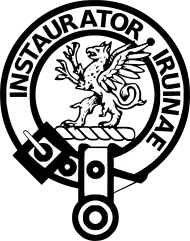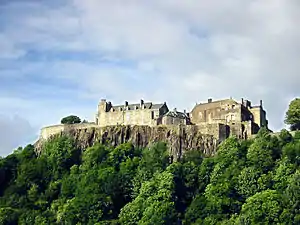Clan Forsyth
Clan Forsyth (Scottish Gaelic: Clann Fearsithe, IPA:[ˈkʰɫ̪aun̴̪ˈfɛɾʃɪhə]) is a Scottish clan.[1]
| Clan Forsyth | |
|---|---|
| Fearsithe | |
 Crest: A griffin sergeant Azure, armed and membered Sable, crowned Or | |
| Motto | Instaurator ruinae (A repairer of ruin) |
| Profile | |
| Region | Lowlands |
| Chief | |
 | |
| Alistair Forsyth of that Ilk | |
| Chief of the Name and Arms of Forsyth | |
| Seat | Ethie Castle |
| Historic seat | Forsyth Castle Inchnoch Castle |
History
Origins of the clan
The history of the Clan Forsyth dates back to before the twelfth century and as is usually the case with families who date back this far, the derivation of the family's surname is uncertain.[1] If the name is of Celtic origin, then it may derive from Fearsithe, which is Scottish Gaelic for man of peace.[1] However, there is a tradition that gives a Norman origin from Forsach, who was amongst the Norsemen who settled on lands on the River Dordogne in Aquitaine, France.[1] The Viscomte de Fronsoc accompanied Eleanor of Provence to marry Henry III of England in London and from 1236 to 1246 lived at the English court.[1] This family are believed to have obtained lands in Northumberland and from there moved to the Scottish Borders.[1]
Wars of Scottish Independence
In 1296 William de Fersith appears on the Ragman Rolls submitting to Edward I of England.[1] Sometime after 1306, Osbert, the son of Robert de Forsyth, received a grant for the lands of Sauchie in Stirlingshire from Robert the Bruce.[1] During the Wars of Scottish Independence Osbert distinguished himself at the Battle of Bannockburn and received confirmation of the realm of his lands under the great seal in 1320.[1]

In 1368 Osbert's son was appointed as the king's macer and as constable of Stirling Castle.[1] Fersith the clerk received a royal pension of one hundred pounds from Robert II of Scotland.[1] Many prominent burgesses and civic dignitaries bore the name and the family became settled around Stirling.[1]
14th, 15th and 16th centuries
Sometime before 1488, David Forsyth of Dykes acquired his lands in Lanarkshire.[1] He specifically claimed the de Fronsocs as his ancestors and his seal bore heraldry similar to their arms.[1] Forsyth Castle which was at Dykes was demolished in 1828.[1] A branch of the clan moved from Dykes to Inchnoch Castle in Monklands and their descendants spread throughout Glasgow and Ayrshire.[1]
William Forsyth had been baillie of Edinburgh in around 1365 and his son, William, moved to St Andrews in 1423 where he subsequently acquired the barony of Nydie.[1] Alexander the fourth Baron of Nydie died at the Battle of Flodden in 1513.[1] His grandson, James, married Elizabeth Leslie who was a granddaughter of the Earl of Rothes and a great-granddaughter of James III of Scotland.[1] The Forsyths fortunes were tied to their extremely powerful relatives and they acquired lands near the royal Falkland Palace.[1] John Forsyth was appointed the king's macer in 1538 and later Falkland Pursuivant.[1] The present chiefs of Clan Forsyth are descended from the Falkland Forsyths.[1]
17th, 18th and 19th centuries
Another branch of the Clan Forsyth settled near Monymusk and William Forsyth represented Forres in the Parliament of 1621.[1] Alexander John Forsyth was a pioneer in the development of modern firearms.[1] In the eighteenth century his work led to the replacement of the flintlock with the percussion lock.[1]
William Forsyth (b.1737), was a distinguished horticulturalist who went to London to study botanical gardens in Chelsea.[1] He was appointed Chief Superintendent of the royal Kensington Gardens and St James's Palace in 1784.[1]
Peter Taylor Forsyth (b.1848) was Principal of Hackney Theological College and in 1909 published his most influential work, The Person and Place of Jesus Christ.[1]
Clan chief
When, in 1672, Charles II instituted a public register of the clans the then chief of Clan Forsyth refused to attend. The clan was subsequently stripped of its recognition and the chief lost his legal title. This situation continued for the next 300 years until St. Andrews Day 1978 when Lord Lyon, King of Arms, accepted the claim of Alistair Forsyth, the Baron of Ethie, to become Chief of the Forsyth clan.
Alistair Forsyth resides in a French chateau having set up a Highland cattle ranch in Western Australia.[2]
Allan Forsyth acts as Clan commissioner in New Zealand. [3]
Clan Castles
- Ethie Castle, Angus & Dundee: About 5 miles north east of Arbroath, on minor roads 2 miles east of A92, about 0.75 miles west of the sea, at Ethie Castle. Now in private ownership. www.ethiecastle.com for more details.
- Inchnoch Castle, Lanarkshire & Glasgow area: About 2.5 miles north of Coatbridge, on minor roads north of B804, about 0.5 miles north east of Mamock. (Ruin – Slight remains survive of a tower house).
- Dykes Castle, Lanarkshire & Glasgow area: About 2 miles west of Stonehouse, on minor roads north of A71, just north of Glassford. (Ruin). Dykes was long a property of the Forsyth family and they built a castle here about 1350. The story goes that the family had defeated an English force and were given the property as a reward.
- Nydie Castle, Fife, about 5 miles west of St Andrews, on minor roads north of B939 or south of A91, south of River Eden, 2 miles north and west of Strathkinnes, at or near Nydie Mains. (Ruin). Nydie was a property of the Forsyth family from 1435 to 1608. 'Needy' is marked on the Atlus Novus map of Fife.
- Polmaise Castle, Stirlingshire & Clackmannan: about 3 miles east and south of Stirling, on minor roads north of A905, just north of Fallin, on southern shore of River Forth, at Polmaise. (Ruin). In the 14th century the lands of Polmaise Marischal were given to the Forsyths.
- Ecclesgreig Castle, located just northwest of St Cyrus, a coastal village in Aberdeenshire. The house and estate has had multiple names and families associated with it throughout the ages. Initially it was known as Criggie, then Mount Cyrus and finally given the name Ecclesgreig by the Forsyth-Grants. It identifies in the Forsyth-Grant ancestry in the period after 1843. House is a ruin and in private ownership. www.ecclesgreig.com for more details.
See also
- Scottish clan
- Forsyth (surname)
- Ethie Castle, the Clan's seat.
- Forsyth–Edwards Notation, a standard notation for describing a particular board position of a chess game.
- USS Forsyth (PF-102), a United States Navy patrol frigate in commission from 1945 to 1946.
- The Forsyth Institute, an oral health research institute based in Boston, Massachusetts.
- Nicolas Denys, "Falsified Genealogies" Section.
- William Forsyth (merchant)
- James W. Forsyth
- Forsyth, Montana
- John Forsyth (loyalist)
References
- Way, George and Squire, Romily. Collins Scottish Clan & Family Encyclopedia. (Foreword by The Rt Hon. The Earl of Elgin KT, Convenor, The Standing Council of Scottish Chiefs). Published in 1994. Pages 140 – 141.
- Clan Forsyth Society - Clan Chief clanforsyth.org.nz. Retrieved 21 September 2013.
- Clan Forsyth Society - N.Z Forsyth Clan Committee clanforsyth.org.nz. Retrieved 27 January 2020.
External links
- New Zealand Branch of Clan Forsyth Society http://www.clanforsyth.org.nz/default.htm
- USA Branch of Clan Forsyth Society http://clanforsyth.com/
- Clan Forsyth Society http://www.clanforsythsociety.net
- Clan Forsyth Australia
- History of Forsyth Clan http://www.rampantscotland.com/clans/blclanforsyth.htm
- Forsyth Heraldry http://www.heraldry-online.org.uk/forsyth/forsyth-arms.html
- Dead PC Tycoon's Estate Eaten up by Credit Card Debts http://www.channelregister.co.uk/2009/04/22/charles_forsyth_legacy/
- Clan Heir Jailed For Fraud http://archive.thenorthernecho.co.uk/2005/4/7/17407.html
- Downfall of Clan Heir Jailed over a Multi-million Con http://www.thefreelibrary.com/Downfall+of+clan+heir+jailed+over+a+multi-million+con;+Computer+fraud...-a0131369574